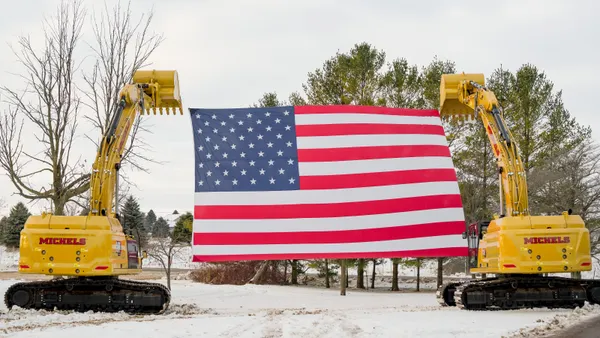Dive Brief:
- The Bureau of Labor Statistics' 2016 Census of Fatal Occupational Injuries revealed that construction worker fatalities increased by 6% from 2015 to 2016, ConstructConnect reported.
- The construction industry logged 991 worker deaths, the highest number of any industry, making up almost 20% of all work-related fatalities in 2016. Construction deaths were 22.2% of the private sector's fatality rate. Even though construction saw the most workers die on the job, it ranked third of all industries in the highest rate of deaths.
- The four major causes of construction deaths — dubbed the Fatal Four by the Occupational Safety and Health Administration — are falls, struck-by incidents, electrocution and caught-in/between accidents. They were responsible for nearly 64% of construction workers deaths in 2016.
Dive Insight:
As far as struck-by incidents go, some happen within the confines of the project, but others are a result of outside threats like distracted or inebriated motorists traveling through a highway work zone. From 2011 to 2015, more than 800 U.S. construction workers died from struck-by incidents, the Center for Construction Research and Training reported, with 18% perishing as a result of being hit by a vehicle. Nearly 60% of those fatalities occurred in work zones.
Clark Peterson, vice president of environmental, health and safety at Skanska USA, told Construction Dive earlier this year that night highway construction operations are particularly dangerous as there is decreased visibility and a greater chance of encountering a sleep-deprived, distracted or under-the-influence driver.
To mitigate some of the danger, day and night, Skanska takes advantage of positive protection measures that increase the likelihood that vehicles stay out of roadside construction areas. These strategies include placement of concrete or ballast-filled barriers on the edges of work areas and using "shadow vehicles" armed with attenuators, mounted devices that will absorb some of the impacts of a crash.
Skanska has also lobbied state governments for harsher penalties for drivers who hit construction workers in a highway work zone, Peterson said. He said consequences for a motorist who accidentally hit a construction worker with a vehicle might be a $300 fine. But new laws in California now allow police officers to treat these incidents as assaults and fine offenders up to $2,000.
Falls, however, continue to be the leading cause of accidental death on construction job sites. And fall protection, according to the National Safety Council, was the most-cited construction industry violation on the preliminary version of OSHA's annual list, released back in September. OSHA has also leveled huge penalties for fall-protection violations if they represent willful or repeated behavior. For example, in August, OSHA fined a Florida roofing contractor more than $1.5 million after the company amassed a number of repeat violation citations.












